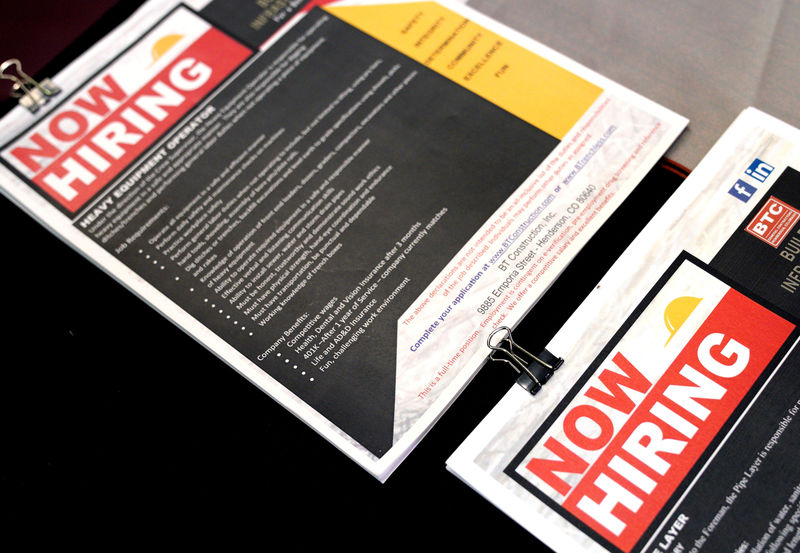By Lucia Mutikani
WASHINGTON, June 7 - U.S. job growth slowed sharply in May and wages rose less than expected, raising fears that a loss of momentum in economic activity could be spreading to the labor market, which could put pressure on the Federal Reserve to cut interest rates this year.
The broad cool-off in hiring reported by the Labor Department on Friday was even before a recent escalation in trade tensions between the United States and two of its major trading partners, China and Mexico. Analysts have warned the trade fights could undermine the economy, which will celebrate 10 years of expansion next month, the longest on record.
The economy thus far has been largely resilient to the trade war with China. President Donald Trump in early May slapped additional tariffs of up to 25% on $200 billion of Chinese goods, which prompted retaliation by Beijing.
Last week, Trump said he would impose a tariff on all goods from Mexico in a bid to force authorities in that country to stop immigrants from Central America from crossing the border into the United States. Talks are ongoing to prevent the duties from kicking in at 5% on June 10. (Full Story)
Fed Chairman Jerome Powell said on Tuesday the central bank was closely monitoring the implications of the trade tensions on the economy and would "act as appropriate to sustain the expansion."
"This report, combined with nerves around tariffs, will be enough to force a rate cut from the Fed in either June or July," said Curt Long, chief economist with the National Association of Federally-Insured Credit Unions.
Nonfarm payrolls increased by 75,000 jobs last month, the government said in its closely watched employment report, falling below the roughly 100,000 needed per month to keep up with growth in the working-age population. Adding a sting to the report, the economy created 75,000 fewer jobs in March and April than previously reported.
Economists polled by Reuters had forecast payrolls rising by 185,000 jobs last month. May's disappointing job growth was flagged by a report on Wednesday from payrolls processing firm ADP (NASDAQ:ADP) showing the smallest gain in private payrolls in nine years last month. Another report this week showed a drop in online ads by businesses looking for help.
Last month's slowdown in job gains, however, probably understates the health of the labor market as measures such as weekly applications for unemployment benefits and the Institute for Supply Management's services employment gauge have suggested underlying strength.
WORKER SHORTAGES
Some of the weakness in hiring last month could be the result worker shortages, especially in the construction, transportation and manufacturing sectors.
Monthly wage growth remained moderate in May, with average hourly earnings increasing six cents, or 0.2% following a similar gain in April. That lowered the annual increase in wages to 3.1% from 3.2% in April. The average workweek was unchanged at 34.4 hours last month.
The moderation in wage gains, if sustained, could cast doubts on the Fed's optimism that inflation would return to the U.S. central bank's 2% target.
U.S. Treasury prices rallied on the employment report, with the yield curve steepening. The dollar dropped against a basket of currencies. U.S. stock index futures pared gains. Financial markets are pricing in a rate cut as early as July and two more later this year.
The tepid employment report added to soft data on consumer spending, business investment, manufacturing and homes sales in suggesting the economy was losing momentum in the second quarter following a temporary boost from exports, inventory accumulation and defense spending. Growth is cooling as the massive stimulus from last year's tax cuts and spending increases fades.
The Atlanta Fed is forecasting gross domestic product rising at a 1.5% annualized rate in the second quarter. The economy grew at a 3.1% pace in the first quarter.
The unemployment rate remained near a 50-year low of 3.6% in May. A broader measure of unemployment, which includes people who want to work but have given up searching and those working part-time because they cannot find full-time employment, dropped two-tenths of a percentage point to 7.1% last month, the lowest since December 2000.
The labor force participation rate, or the proportion of working-age Americans who have a job or are looking for one, was unchanged at 62.8% last month.
Hiring slowed across all sectors in May. Manufacturing payrolls increased by 3,000 last month, after gaining 5,000 positions in April. The sector is struggling with an inventory overhang that has resulted in businesses placing fewer orders at factories.

Manufacturing payrolls will be watched closely for signs of any fallout from the trade tensions. Factory output has weakened and sentiment dropped to a 31-month low in May, with manufacturers worried mostly about the trade tensions.
Employers in the construction sector hired 4,000 workers in May after adding 30,000 jobs to payrolls in April. Leisure and hospitality sector payrolls increased by 26,000 jobs last month.
Professional and business services employment rose by 33,000. Transportation and warehousing payrolls fell as did retail employment. Government shed 15,000 jobs, the most since January 2018.